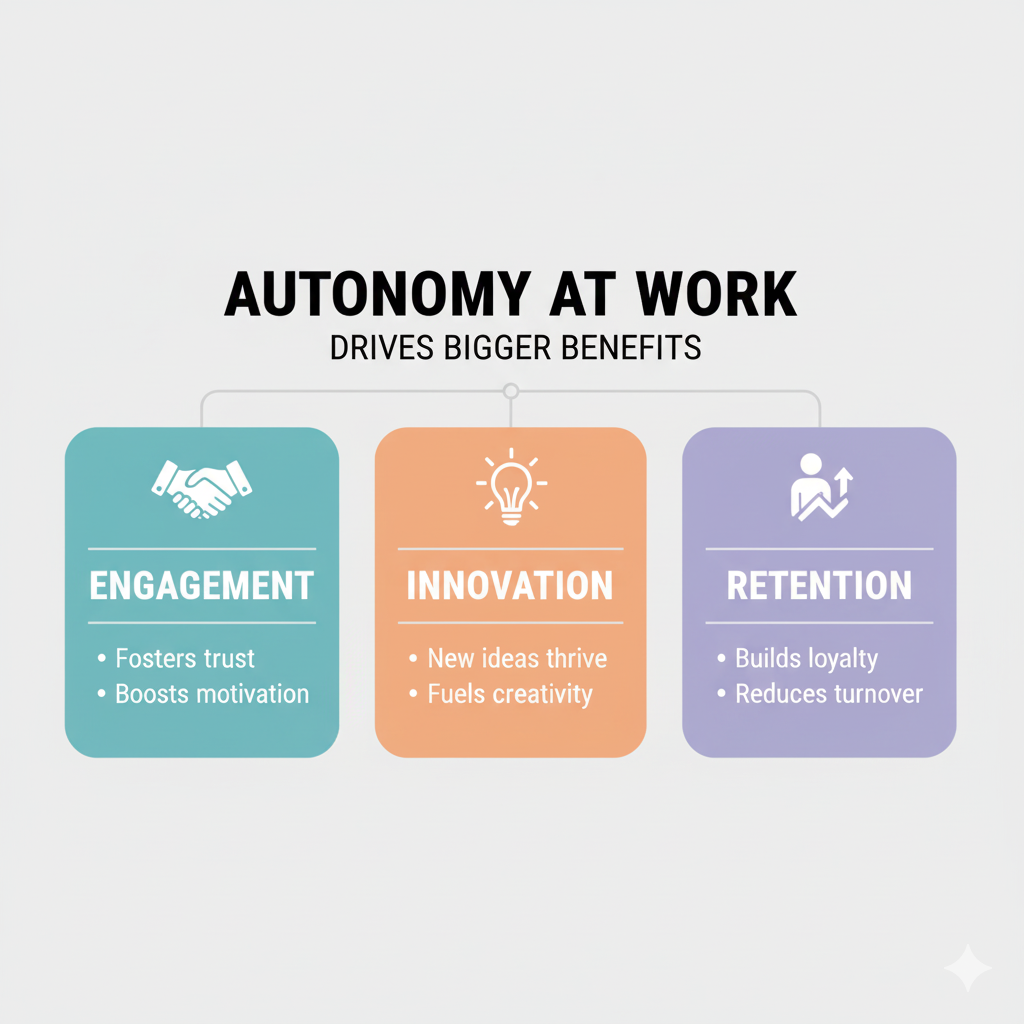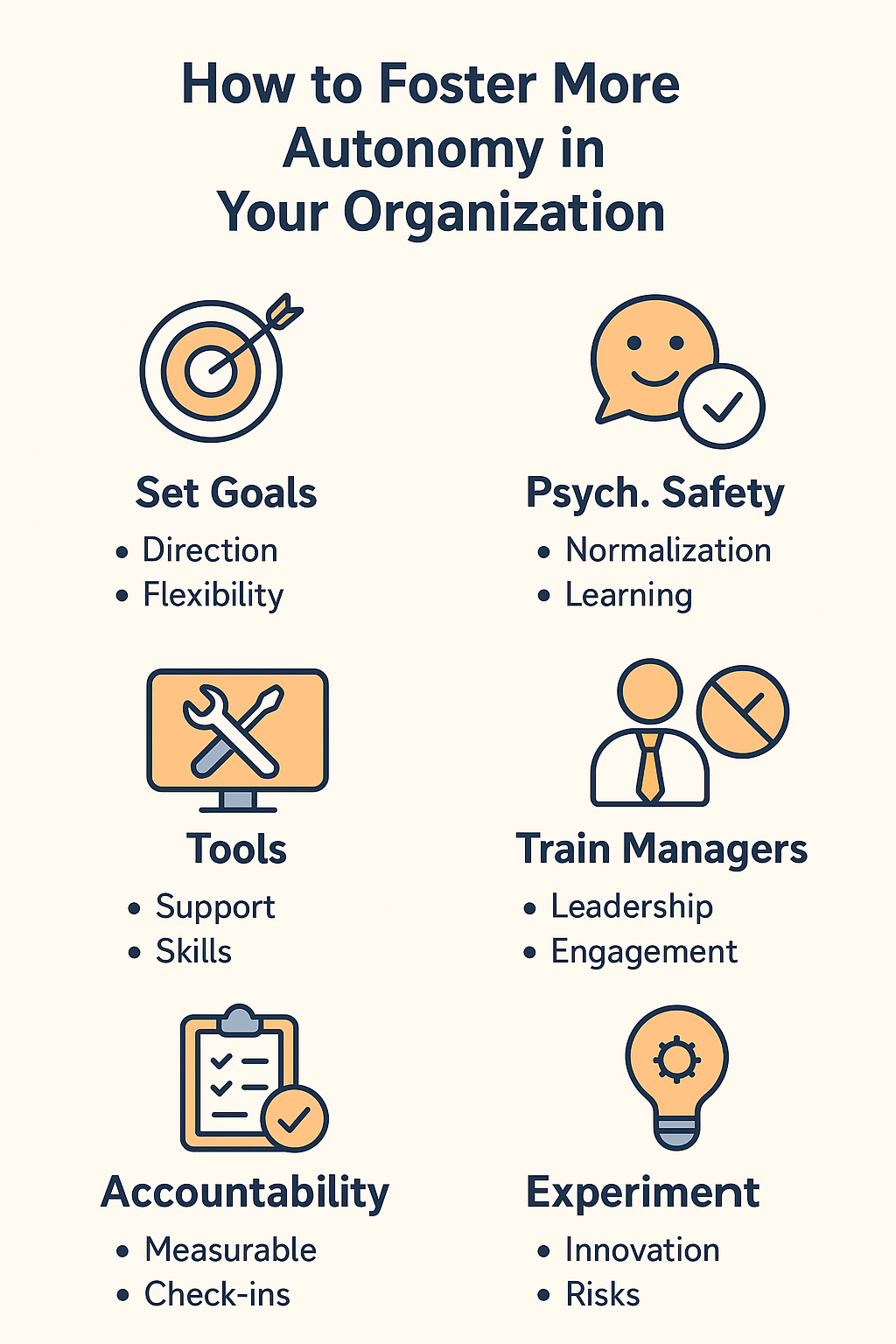Imagine walking into work every day only to find your manager hovering over your shoulder, second-guessing every move. Your schedule is fixed, your process is dictated, and your input does not matter. It is frustrating, and for many employees today, it is reality. Research by Gallup shows that nearly 79% of workers feel disengaged because they lack freedom in how they do their jobs. At the same time, 77% of employees are at risk of burnout when they feel controlled or micromanaged.
This is where autonomy in the workplace comes in. At its core, autonomy means giving employees the ability to make decisions about their work, whether it is how, when, or even why they do it. It does not mean no supervision or chaos. Instead, it is about trust, empowerment, and balance.
The need for autonomy is more urgent than ever. Remote and hybrid work have redefined expectations. Younger generations also demand flexibility and purpose in their roles. Companies that fail to adapt risk disengagement, high turnover, and shrinking innovation. But when done right, autonomy fuels creativity, boosts well-being, and creates workplaces where people genuinely want to contribute.
In this article, we will explore what autonomy at work really means, why it matters, real-world examples, and practical ways to build it in your organization. You will see how fostering autonomy can transform not only employee experience but also business performance.
What Does Autonomy Mean in the Workplace?
Autonomy is often confused with flexibility, but they are not the same. Flexibility is about adjusting schedules or locations, while autonomy is about control over one’s work. It answers the question: how much freedom do employees have to decide what, when, and how they contribute?
Different researches highlight that autonomy extends beyond just working hours. It is about letting employees craft processes, influence decisions, and even shape their long-term career paths. To make it simple, autonomy at work comes in different forms:
Task Autonomy
Employees choose how to complete assigned tasks. Instead of rigid instructions, they find the most efficient or creative approach.
Schedule Autonomy
Employee has the freedom to decide when work happens, whether through flexible hours, compressed workweeks, or remote arrangements.
Decision-Making Autonomy
Employees can influence team or project-level choices, from deadlines to strategies.
Creative Autonomy
Employee has the freedom to propose new ideas, experiment, and innovate without excessive approval barriers.
Career Autonomy
Employees shape their career trajectory by choosing skills to develop, projects to join, or future roles.
Social Autonomy
They have the freedom to decide with whom and how to collaborate, which fosters stronger ownership of team dynamics.
So, what does autonomy mean in the workplace? It is the combination of these freedoms, adjusted by role and responsibility, that gives employees a sense of ownership. And when employees feel ownership, they are far more motivated to perform.

Why Autonomy at Work Matters
Understanding autonomy is one thing, knowing why it matters is another. Autonomy is not just a perk. It is a driver of measurable business outcomes. Studies consistently show that organizations with higher autonomy experience stronger engagement, creativity, and retention. Let us break down the core benefits:
Higher Engagement
Employees with autonomy feel trusted, and trust drives engagement. A Wharton study found that autonomy directly links to greater satisfaction and motivation.
Better Well-being and Lower Burnout
According to Lyra Health, lack of control is a top predictor of workplace stress. Autonomy helps employees balance workload, which reduces burnout and absenteeism.
Stronger Innovation and Creativity
When employees can test ideas and make decisions, innovation thrives. Autonomy fuels risk-taking that leads to breakthroughs.
Retention and Reduced Turnover
PMC studies show employees are more loyal when they have autonomy. Conversely, low autonomy leads to presenteeism, disengagement, and attrition.
On the flip side, when organizations ignore autonomy, costs stack up. There is higher turnover, lower productivity, and employees who show up but mentally check out. In today’s market, where talent has options, autonomy is no longer optional.
Examples of Autonomy at Work in Action
Understanding autonomy in theory is helpful, but seeing it in practice makes the concept real. Many organizations already integrate autonomy into their workflows, sometimes without labeling it as such. Below are concrete examples of autonomy at work that show how freedom and structure can coexist.
Choosing Work Schedules
One of the most visible forms of autonomy is schedule flexibility. Employees may decide when to start and end their day, or whether to work from home part of the week. Companies like Microsoft have experimented with hybrid models where teams set their own rhythm, and the results show higher employee satisfaction and lower turnover.
Designing Their Own Processes
Instead of dictating step-by-step workflows, leaders can empower teams to create the processes that suit them best. For example, a marketing team might decide how to split campaign responsibilities or which tools to adopt. This ownership creates both efficiency and accountability.
Contributing to Decision-Making
Employees thrive when they can influence deadlines, priorities, or even product features. A study highlighted by Betterworks shows that teams with a voice in goal-setting achieve those goals 20% more often. Autonomy in decision-making strengthens buy-in and reduces resistance.
Giving Input on Team Benefits
Some organizations invite employees to shape the perks they receive, whether that is wellness allowances, training budgets, or community initiatives. This small but powerful step shows employees that their voices matter.
Case studies bring these examples to life. For instance, a global tech company analyzed by PMC shifted from micromanagement to self-directed project teams. The outcome was not only a 15% rise in productivity but also higher retention of skilled employees. Another study showed that employees with schedule autonomy reported 32% lower stress levels compared to those with rigid schedules.
These examples prove that autonomy does not mean letting go of control. Instead, it is about aligning trust with responsibility so employees feel ownership and organizations achieve better outcomes.

How to Foster More Autonomy in Your Organization
Giving employees freedom is not as simple as saying, “Do what you want.” Leaders must balance empowerment with accountability. Creating a culture of autonomy requires intentional practices that provide clarity while granting flexibility. Here are proven ways to foster autonomy at work:
Set Clear Goals but Let Employees Choose How
Autonomy does not work without direction. Leaders should define the “what” but let employees decide the “how.” For example, instead of prescribing steps, set clear objectives such as improving customer satisfaction scores by 10% and allow the team to design the path.
Encourage Psychological Safety
Employees will not take initiative if they fear punishment for mistakes. Managers should normalize experimentation and view setbacks as learning opportunities. Google’s research on high-performing teams shows psychological safety is the single most important factor in team success.
Provide Tools, Training, and Resources
Autonomy requires support. Employees cannot thrive if they lack the skills or technology to act independently. Organizations should invest in training programs, collaboration platforms, and knowledge-sharing systems that make self-directed work possible.
Train Managers Against Micromanagement
Many autonomy initiatives fail because managers cling to control. Leadership training should help managers shift from “command and control” to “guide and coach.” It is found that teams with supportive managers are 31% more engaged.
Establish Accountability Systems with Freedom
Autonomy without accountability can create chaos. A balance is achieved by setting measurable outcomes and regular check-ins. Employees know what is expected but still control how they deliver.
Encourage Experimentation and Calculated Risks
Autonomy fuels innovation when employees are free to test ideas. Companies like 3M and Google famously allow employees to use part of their time for personal projects, leading to breakthroughs like Post-it Notes and Gmail.
Customize Autonomy by Role
Not every job can support the same level of freedom. For example, a factory worker may not control production schedules but can have autonomy in how they organize tasks or suggest improvements. Leaders must tailor autonomy so it is realistic and fair.
When organizations follow these steps, autonomy moves from a vague idea to a structured cultural shift. Employees feel trusted, managers gain stronger teams, and companies unlock higher productivity.
Challenges and How to Overcome Them
Even though autonomy in the workplace brings many benefits, it is not without challenges. Leaders often hesitate to grant autonomy because they fear chaos, lack of control, or uneven results. These concerns are valid, but each can be addressed with the right strategies.
Lack of Alignment Leads to Chaos
When autonomy is introduced without clear goals, employees may work in different directions, creating confusion. The solution is to set transparent objectives and communicate priorities so autonomy operates within boundaries.
Uneven Performance Across Teams
Not all employees adapt to autonomy at the same pace. Some may thrive, while others may struggle without close supervision. To address this, managers should tailor autonomy to individual readiness and provide coaching where needed.
Employees Overwhelmed by Too Many Decisions
While autonomy gives freedom, too many choices can lead to decision fatigue. Guardrails, such as preset templates or decision-making frameworks, help employees focus without feeling overloaded.
Decline in Quality if Unmanaged
Without accountability systems, autonomy might result in inconsistent outcomes. The answer is feedback loops, regular check-ins, and clear quality standards. Employees maintain flexibility but remain accountable for results.
These challenges show that autonomy should not mean “anything goes.” Instead, it requires careful planning, structured feedback, and supportive leadership to ensure it benefits both employees and organizations.
Autonomy, Job Crafting, and Meaningful Work
Autonomy is not just about flexibility in schedules or decision-making. It connects deeply with how employees shape their roles, a concept known as job crafting. Job crafting occurs when employees actively adjust tasks, relationships, or approaches to align with their strengths, interests, and motivations.
Research published in the National Library of Medicine (PMC study) highlights that autonomy is a key driver of job crafting. When employees feel empowered to influence how they work, they are more likely to redesign their tasks in ways that bring meaning. For example, a nurse who is given autonomy may choose to spend extra time educating patients about preventive care. This not only improves patient outcomes but also makes the nurse’s work more fulfilling.
Autonomy also ties directly to meaningful work. Employees who can shape their roles report higher engagement, stronger resilience during stressful times, and greater overall well-being. In contrast, rigid job designs often lead to disengagement and burnout.
Organizations that encourage autonomy in job crafting unlock hidden potential within their teams. By allowing employees to match their work with their values and strengths, they create an environment where people thrive, innovate, and stay committed long term.

Let Yuna Support Autonomy in Your Workplace
Autonomy in the workplace is not just a modern buzzword. It is one of the most powerful ways to improve employee well-being, increase engagement, and drive long-term performance. When people have freedom in how they work, they become more motivated, more innovative, and more loyal to their organizations.
But building autonomy is not always easy. It requires balance — trust combined with accountability, flexibility supported by clarity. That is where Yuna makes a difference.
Yuna empowers organizations to create healthier, more autonomous workplaces by providing:
- Employee feedback loops that capture real insights into how teams feel about their level of independence.
- AI-driven analytics that highlight engagement trends and spot areas where autonomy can be improved.
- Tools for managers to guide teams with the right mix of support and freedom, reducing the risk of micromanagement.
With Yuna, companies can measure autonomy in action and implement changes that boost both performance and employee satisfaction.
If you want to unlock the full potential of your workforce, start by building autonomy at work. And with Yuna by your side, you can create an environment where trust, growth, and resilience thrive together.
FAQs
What is autonomy in the workplace?
Autonomy in the workplace means giving employees the freedom to decide how, when, and sometimes what work they do. It empowers them to take ownership of tasks while still being accountable for outcomes.
How much autonomy should a manager grant?
The right level of autonomy depends on the role, employee experience, and organizational goals. Managers should provide clear direction but allow employees enough freedom to make decisions and grow.
Is autonomy the same as no supervision?
No, autonomy is not about eliminating supervision. Instead, it shifts the manager’s role from micromanaging to guiding, coaching, and ensuring accountability without limiting independence.
Does autonomy work in all types of jobs?
Autonomy can be applied to almost any role, but the level varies. Office roles may have schedule and decision autonomy, while operational roles might have autonomy in methods or improvements.
What are some examples of autonomy at work?
Examples include choosing flexible schedules, designing work processes, contributing to project goals, and providing input on team benefits. These practices boost engagement and trust.



.webp)


